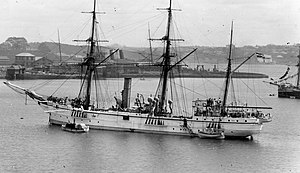SMS Seagull (1879)
|
|
||
|---|---|---|

|
||
| Construction data | ||
| Ship type | Gunboat | |
| Builder: | F. Schichau , Elbing , construction no .: 143 | |
| Launch : | May 13, 1879 | |
| in service: | May 31, 1880 | |
| painted: | December 9, 1905 | |
| Sister ship | SMS hawk | |
| Technical specifications | ||
| Displacement : | Construction: 840 t Maximum: 1005 t |
|
| Length: |
KWL : 53.8 m over all: 59.2 m |
|
| Width: | 8.9 m | |
| Draft : | 3.52 - 4.18 m | |
| Machinery: |
|
|
| Number of screws: | 1 double-leaf (Ø 3.23 m) | |
| Power: | 886 PSi | |
| Top speed: | 11.7 kn | |
| Rig | ||
| Rigging : | Barkentine , last of all Rahschoner | |
| Masts: | 3 | |
| Sail area: | 847 m², finally 361 m² | |
| Crew size: | 127 men | |
| Armament | ||
| originally: |
|
|
| 1883: | additional 5 revolver cannons | |
| Whereabouts | ||
| Wrecked in 1910 | ||
SMS Seagull was a gunboat of the Imperial Navy in the late 1870s.
The only structurally identical sister ship was the SMS Habicht . This was followed later by the larger half-sister ship SMS Adler , built on the basis of the same design . The ship is the namesake of Möwebucht in today's Namibia .
history
The gunboat was at F. Schichau in Elbing built and ran there in 1879 from stack .
The seagull was mainly used in foreign service and was also used for colonial acquisitions in West Africa . The first " declaration of protection " on site took place in the Gulf of Guinea; The German Africa explorer Gustav Nachtigal was on board . On July 4, 1884, the seagull was anchored at Bagida off the coast of Togo and Togo was declared a German colony. On July 14, 1884, Gustav Nachtigal concluded protection treaties with a number of Duala headmen in the presence of the seagull in Bellstadt ( Douala ) , hoisted the German flag and took possession of Cameroon as a colony for the German Empire . After that, the seagull hoisted flags in the coastal areas of Nigeria , Gabon , Togo and Angola . Then she participated in the founding of the colony German South West Africa . A landing corps of the warship took part in the suppression of the so-called Arab uprising in German East Africa in 1889 .
From 1895 she was used as a survey ship for coastal surveying in the German protected areas in the South Seas and in German New Guinea .
On December 9, 1905, the gunboat was removed from the list of warships. It then lay as the Hulk in Tsingtau until it was finally sold in 1910.
technology
The ship was 52.2 m long and 8.90 m wide and had a draft of 3.52 m. The crew numbered 127 men. The water displacement was 845 tons. The ship was a composite structure with iron crossbars and wooden planks, which were also covered with zinc plates . Two cylinder boilers provided the necessary steam, and a horizontal 3-cylinder twin steam engine with an output of 652 kW (886 PSi) provided the energy to operate the heatable screw with a diameter of 3.23 meters. The maximum speed was 11.7 kts . With a coal reserve of 100 tons, it was possible to travel around 1230 nautical miles at a cruising speed of 11 knots. The seagull had no electrical systems on board.
The ship was originally rigged as a barquentine and had a sail area of 847 m². After reconstruction it was most recently Rahschoner rigged with 361 sqm sail area.
Armament
The ship, also designated as Aviso , was initially armed with a 15 cm ring cannon and four 12 cm ring cannons. This armament was replaced by five 12.5 cm ring cannons in 1882, which were reduced to two in 1890. Furthermore, from 1882 five 3.7 cm revolver cannons were on board.
The maximum stock of ammunition initially consisted of 115 rounds of 15 cm grenades and 440 rounds of 12 cm grenades. After the conversion, 620 rounds of 12.5 cm grenades could be carried. From 1890 storage space was only provided for 246 shells of this caliber .
literature
- Erich Gröner , Dieter Jung, Martin Maass: The German warships 1815-1945 , volume 1. Bernard & Graefe, Munich 1982, ISBN 3-7637-4800-8 .
- Hans H. Hildebrand, Albert Röhr, Hans-Otto Steinmetz: Die deutschen Kriegsschiffe Volume 4, 1st edition, Herford 1982, ISBN 3-7822-0235-X , p. 126 ff.
- Johannes Wilda : Journey on SMS "Möwe". Forays into the South Sea colonies and East Asia. Berlin 1903. [1]
Web links
- Brief description with picture on deutsche-schutzgebiete.de
Individual evidence
- ^ Mowe Bay. The Cardboard Box. Retrieved February 13, 2020.